状语从句
- 格式:doc
- 大小:89.50 KB
- 文档页数:8

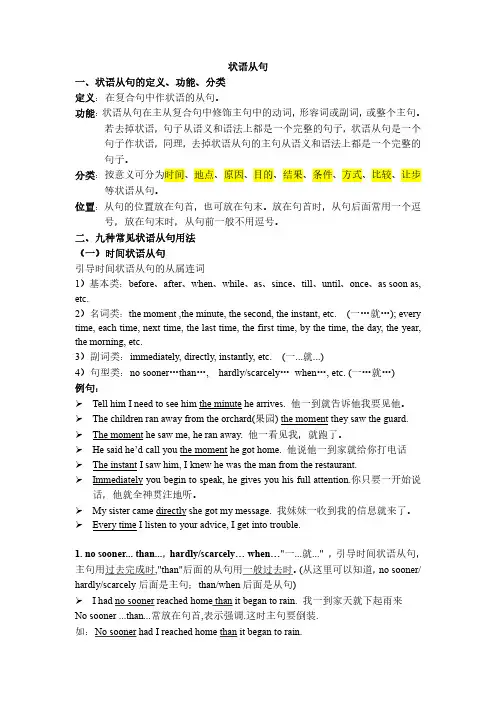
状语从句一、状语从句的定义、功能、分类定义:在复合句中作状语的从句。
功能:状语从句在主从复合句中修饰主句中的动词,形容词或副词,或整个主句。
若去掉状语,句子从语义和语法上都是一个完整的句子,状语从句是一个句子作状语,同理,去掉状语从句的主句从语义和语法上都是一个完整的句子。
分类:按意义可分为时间、地点、原因、目的、结果、条件、方式、比较、让步等状语从句。
位置:从句的位置放在句首,也可放在句末。
放在句首时,从句后面常用一个逗号,放在句末时,从句前一般不用逗号。
二、九种常见状语从句用法(一)时间状语从句引导时间状语从句的从属连词1)基本类:before、after、when、while、as、since、till、until、once、as soon as, etc.2)名词类:the moment ,the minute, the second, the instant, etc. (一…就…); every time, each time, next time, the last time, the first time, by the time, the day, the year, the morning, etc.3)副词类:immediately, directly, instantly, etc. (一...就...)4)句型类:no sooner…than…, hardly/scarcely…when…, etc. (一…就…)例句:Tell him I need to see him the minute he arrives. 他一到就告诉他我要见他。
The children ran away from the orchard(果园) the moment they saw the guard.The moment he saw me, he ran away. 他一看见我,就跑了。
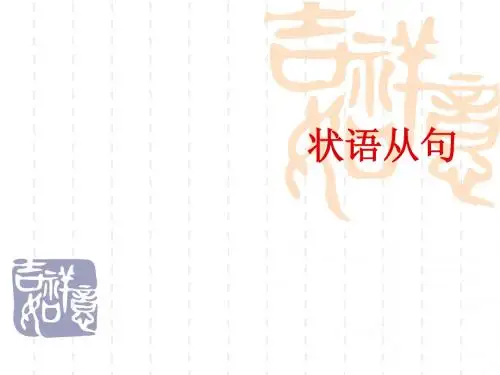
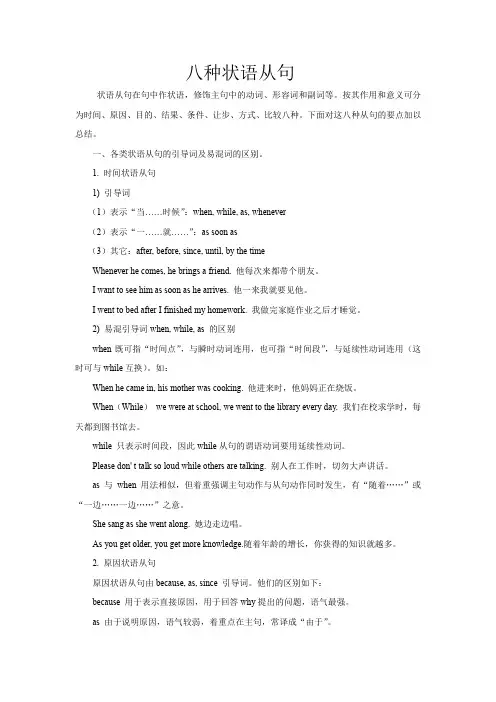
八种状语从句状语从句在句中作状语,修饰主句中的动词、形容词和副词等。
按其作用和意义可分为时间、原因、目的、结果、条件、让步、方式、比较八种。
下面对这八种从句的要点加以总结。
一、各类状语从句的引导词及易混词的区别。
1. 时间状语从句1) 引导词(1)表示“当……时候”:when, while, as, whenever(2)表示“一……就……”:as soon as(3)其它:after, before, since, until, by the timeWhenever he comes, he brings a friend. 他每次来都带个朋友。
I want to see him as soon as he arrives. 他一来我就要见他。
I went to bed after I finished my homework. 我做完家庭作业之后才睡觉。
2) 易混引导词when, while, as 的区别when既可指“时间点”,与瞬时动词连用,也可指“时间段”,与延续性动词连用(这时可与while互换)。
如:When he came in, his mother was cooking. 他进来时,他妈妈正在烧饭。
When(While)we were at school, we went to the library every day. 我们在校求学时,每天都到图书馆去。
while 只表示时间段,因此while从句的谓语动词要用延续性动词。
Please don' t talk so loud while others are talking. 别人在工作时,切勿大声讲话。
as 与when 用法相似,但着重强调主句动作与从句动作同时发生,有“随着……”或“一边……一边……”之意。
She sang as she went along. 她边走边唱。
As you get older, you get more knowledge.随着年龄的增长,你获得的知识就越多。
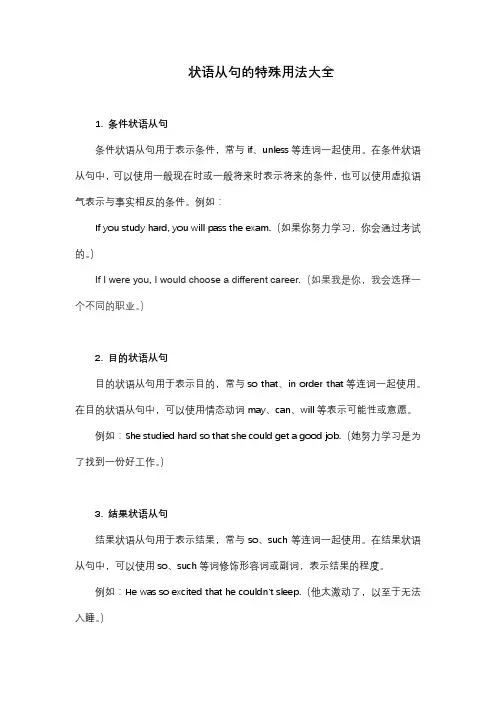
状语从句的特殊用法大全1. 条件状语从句条件状语从句用于表示条件,常与if、unless等连词一起使用。
在条件状语从句中,可以使用一般现在时或一般将来时表示将来的条件,也可以使用虚拟语气表示与事实相反的条件。
例如:If you study hard, you will pass the exam.(如果你努力学习,你会通过考试的。
)If I were you, I would choose a different career.(如果我是你,我会选择一个不同的职业。
)2. 目的状语从句目的状语从句用于表示目的,常与so that、in order that等连词一起使用。
在目的状语从句中,可以使用情态动词may、can、will等表示可能性或意愿。
例如:She studied hard so that she could get a good job.(她努力学习是为了找到一份好工作。
)3. 结果状语从句结果状语从句用于表示结果,常与so、such等连词一起使用。
在结果状语从句中,可以使用so、such等词修饰形容词或副词,表示结果的程度。
例如:He was so excited that he couldn't sleep.(他太激动了,以至于无法入睡。
)4. 地点状语从句地点状语从句用于表示地点,常与where、wherever等连词一起使用。
在地点状语从句中,可以使用陈述句或虚拟语气,表示具体地点或可能性。
例如:Go where you want to go.(去你想去的地方。
)5. 时间状语从句时间状语从句用于表示时间,常与when、whenever等连词一起使用。
在时间状语从句中,可以使用一般现在时、一般过去时、将来时等表示具体时间或时间顺序。
例如:When you are ready, we can start.(当你准备好了,我们就可以开始。
)6. 让步状语从句让步状语从句用于表示尽管有困难或反对,但仍然坚持做某事。
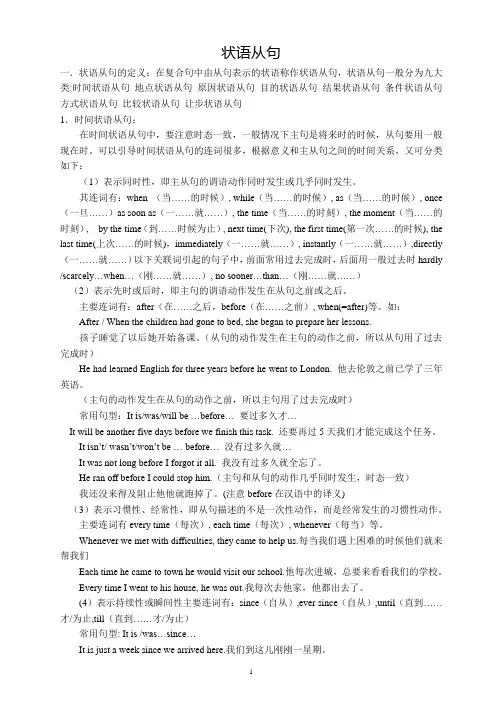
状语从句一.状语从句的定义:在复合句中由从句表示的状语称作状语从句,状语从句一般分为九大类:时间状语从句地点状语从句原因状语从句目的状语从句结果状语从句条件状语从句方式状语从句比较状语从句让步状语从句1.时间状语从句:在时间状语从句中,要注意时态一致,一般情况下主句是将来时的时候,从句要用一般现在时。
可以引导时间状语从句的连词很多,根据意义和主从句之间的时间关系,又可分类如下:(1)表示同时性,即主从句的谓语动作同时发生或几乎同时发生。
其连词有:when (当……的时候), while(当……的时候), as(当……的时候), once (一旦……)as soon as(一……就……), the time(当……的时刻), the moment(当……的时刻),by the time(到……时候为止), next time(下次), the first time(第一次……的时候), the last time(上次……的时候),immediately(一……就……), instantly(一……就……),directly (一……就……)以下关联词引起的句子中,前面常用过去完成时,后面用一般过去时hardly /scarcely…when…(刚……就……), no sooner…than…(刚……就……)(2)表示先时或后时,即主句的谓语动作发生在从句之前或之后。
主要连词有:after(在……之后,before(在……之前), when(=after)等。
如:After / When the children had gone to bed, she began to prepare her lessons.孩子睡觉了以后她开始备课。
(从句的动作发生在主句的动作之前,所以从句用了过去完成时)He had learned English for three years before he went to London. 他去伦敦之前已学了三年英语。
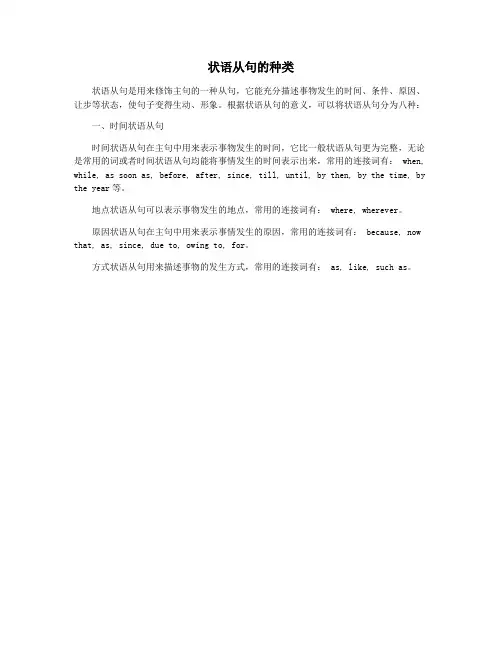
状语从句的种类
状语从句是用来修饰主句的一种从句,它能充分描述事物发生的时间、条件、原因、让步等状态,使句子变得生动、形象。
根据状语从句的意义,可以将状语从句分为八种:
一、时间状语从句
时间状语从句在主句中用来表示事物发生的时间,它比一般状语从句更为完整,无论是常用的词或者时间状语从句均能将事情发生的时间表示出来,常用的连接词有: when, while, as soon as, before, after, since, till, until, by then, by the time, by the year等。
地点状语从句可以表示事物发生的地点,常用的连接词有: where, wherever。
原因状语从句在主句中用来表示事情发生的原因,常用的连接词有: because, now that, as, since, due to, owing to, for。
方式状语从句用来描述事物的发生方式,常用的连接词有: as, like, such as。
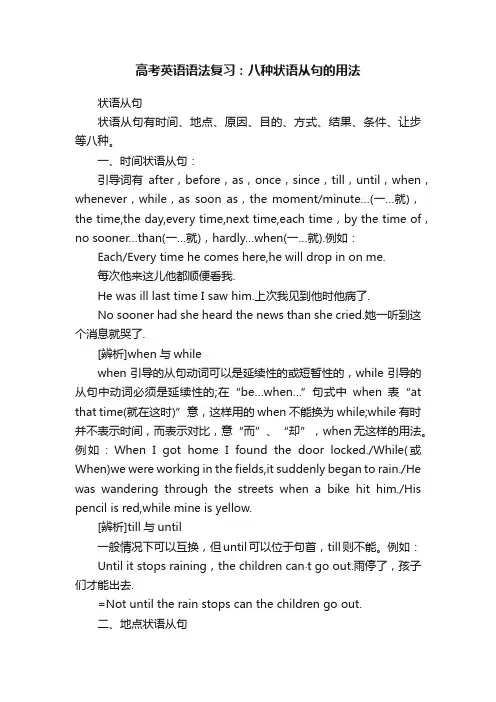
高考英语语法复习:八种状语从句的用法状语从句状语从句有时间、地点、原因、目的、方式、结果、条件、让步等八种。
一、时间状语从句:引导词有after,before,as,once,since,till,until,when,whenever,while,as soon as,the moment/minute…(一…就),the time,the day,every time,next time,each time,by the time of,no sooner…than(一…就),hardly…when(一…就).例如:Each/Every time he comes here,he will drop in on me.每次他来这儿他都顺便看我.He was ill last time I saw him.上次我见到他时他病了.No sooner had she heard the news than she cried.她一听到这个消息就哭了.[辨析]when与whilewhen引导的从句动词可以是延续性的或短暂性的,while引导的从句中动词必须是延续性的;在“be…when…”句式中when表“at that time(就在这时)”意,这样用的when不能换为while;while有时并不表示时间,而表示对比,意“而”、“却”,when无这样的用法。
例如:When I got home I found the door locked./While(或When)we were working in the fields,it suddenly began to rain./He was wandering through the streets when a bike hit him./His pencil is red,while mine is yellow.[辨析]till与until一般情况下可以互换,但until可以位于句首,till则不能。

状语从句的定义1、状语从句又称为状语性从句,是一种用来修饰句子成分(主要是表语、状语、宾语以及定语)的从句。
它的作用是起到充当状语的作用,用来表示状态、条件、原因、时间、让步、地点、方式、结果等,它一般位于句中的句首、句末或句中,有时还放在句子的中间。
2、状语从句可以用关系副词(when、where、why、how等)或关系代词(that、which、who等)来引导,其中关系副词引导的状语从句又可以称为副词性状语从句,而关系代词引导的状语从句可以称为代词性状语从句。
3、副词性状语从句主要有时间、地点、条件、原因、让步、目的、结果等状语从句,常用的副词有when、where、why、how等,而代词性状语从句则有性质、数量、原因、时间等状语从句,常用的代词有that、which、who、whom等。
4、时间状语从句是最常见的一种状语从句,通常用when、while、as、since、until等引导,它主要用来表示句子发生的时间,例如:I will go there when it is time。
5、地点状语从句也是常见的一种,通常用where引导,它主要用来表示句子发生的地点,例如:I live in a place where there is nopollution.6、条件状语从句是一种用来表示条件的状语从句,通常用if或unless引导,例如:I will go there if it is time。
7、原因状语从句是一种表示原因的状语从句,通常用because或since引导,例如:I'm late because I missed the bus.8、让步状语从句是一种表示让步关系的状语从句,通常用though、although、even though等引导,例如:Although it is late, I'm still going there.9、目的状语从句是一种表示目的的状语从句,通常用so that引导,例如:I will go to bed early tonight so that I can get up early tomorrow.10、结果状语从句是一种表示结果的状语从句,通常用so…that或such…that引导,例如:I was so tired that I fell asleep at once.。
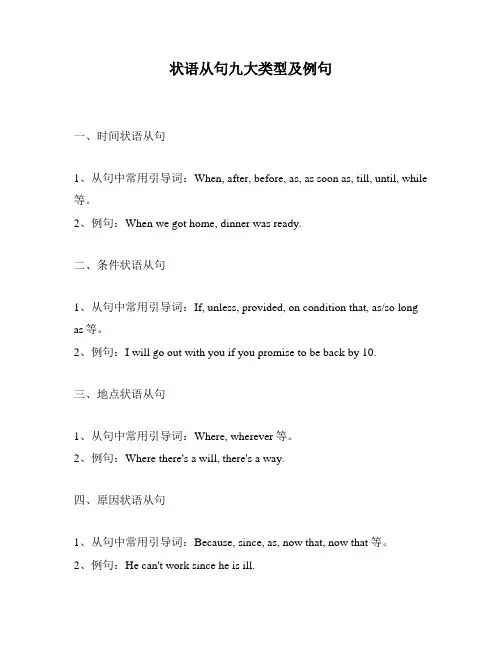
状语从句九大类型及例句一、时间状语从句1、从句中常用引导词:When, after, before, as, as soon as, till, until, while 等。
2、例句:When we got home, dinner was ready.二、条件状语从句1、从句中常用引导词:If, unless, provided, on condition that, as/so long as等。
2、例句:I will go out with you if you promise to be back by 10.三、地点状语从句1、从句中常用引导词:Where, wherever等。
2、例句:Where there's a will, there's a way.四、原因状语从句1、从句中常用引导词:Because, since, as, now that, now that等。
2、例句:He can't work since he is ill.五、结果状语从句1、从句中常用引导词:So that, so..that, such...that, that等。
2、例句:They worked so hard that they succeeded in the end.六、让步状语从句1、从句中常用引导词:Though, although, even though, whatever, whichever等。
2、例句:Though it rained heavily, the sports meeting went on.七、比较状语从句1、从句中常用引导词:Than, as, as...as, not so...as等。
2、例句:You ought to work harder than you do now.八、方式状语从句1、从句中常用引导词:As, as if, as though, like等。
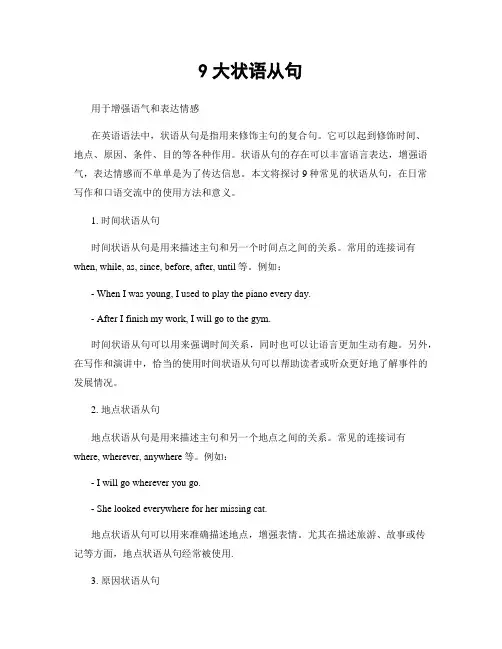
9大状语从句用于增强语气和表达情感在英语语法中,状语从句是指用来修饰主句的复合句。
它可以起到修饰时间、地点、原因、条件、目的等各种作用。
状语从句的存在可以丰富语言表达,增强语气,表达情感而不单单是为了传达信息。
本文将探讨9种常见的状语从句,在日常写作和口语交流中的使用方法和意义。
1. 时间状语从句时间状语从句是用来描述主句和另一个时间点之间的关系。
常用的连接词有when, while, as, since, before, after, until等。
例如:- When I was young, I used to play the piano every day.- After I finish my work, I will go to the gym.时间状语从句可以用来强调时间关系,同时也可以让语言更加生动有趣。
另外,在写作和演讲中,恰当的使用时间状语从句可以帮助读者或听众更好地了解事件的发展情况。
2. 地点状语从句地点状语从句是用来描述主句和另一个地点之间的关系。
常见的连接词有where, wherever, anywhere等。
例如:- I will go wherever you go.- She looked everywhere for her missing cat.地点状语从句可以用来准确描述地点,增强表情。
尤其在描述旅游、故事或传记等方面,地点状语从句经常被使用.3. 原因状语从句原因状语从句是用来描述主句和某个原因之间的关系。
常见的连接词有because, since, as, for等。
例如:- Because it was raining, I stayed at home last night.- I don't like to eat fish, for I am allergic to it.原因状语从句可以强调某个事件的原因,增强语气。
通过使用原因状语从句,写作者或者说话人可以清晰地表达某个事情的原因,使文章更加步入事实,增强可信程度。
完整版)状语从句(9种全)状语从句在复合句中起到修饰主句的作用,分为时间、地点、原因、目的、结果、条件、方式、比较、让步等种类。
1.时间状语从句时间状语从句的连接词包括when。
as。
while。
after。
before。
since。
ever since。
as soon as。
once。
till。
until。
whenever。
no sooner…than。
hardly/scarcely。
when。
the moment/minute/instant/second。
every time。
each time。
any time。
the first time。
next time。
last time。
all the time。
by the time。
directly。
immediately。
instantly等。
例如,“一···就···”的句型可以用as soon as或once引导,其中as soon as侧重时间或动作先后衔接紧,而once侧重条件,表示“一旦。
”;on doing sth/on one's + n.作时间状语,例如On arriving at the n。
the thief was arrested.意为“一到达车站,这个小偷就被逮捕了。
”2.地点状语从句地点状语从句的连接词包括where。
wherever。
anywhere。
everywhere等。
例如,I'll go wherever you go.意为“你去哪儿,我就跟你去哪儿。
”3.原因状语从句原因状语从句的连接词包括because。
since。
as。
now that。
seeing that。
considering that等。
例如,Since it's raining。
we'll stay indoors.意为“因为下雨,我们将待在室内。
英语状语从句的九种类型状语从句是英语语法中一个非常重要的部分。
它可以用来修饰主句的动词,形容词,副词等,从而使句子更加完整,更加准确。
在状语从句中,最常见的就是状语从句。
状语从句可以分为九种类型,分别是时间状语从句,条件状语从句,原因状语从句,目的状语从句,结果状语从句,让步状语从句,方式状语从句,比较状语从句和地点状语从句。
下面我们将对这九种类型进行详细的介绍。
一、时间状语从句时间状语从句用来表示主句中所描述的动作发生的时间,包括过去、现在和将来。
时间状语从句通常由时间连词引导,如when、while、as soon as、before、after、since、until、till等等。
例如:I will call you as soon as I arrive in Beijing.(我到北京后会立即给你打电话。
)He had finished his homework before he went to bed.(他睡觉前已经完成了作业。
)二、条件状语从句条件状语从句用来表示主句中的动作发生的条件或假设。
条件状语从句通常由if、unless、provided that、in case等引导。
例如: If it rains tomorrow, we will stay at home.(如果明天下雨,我们会呆在家里。
)Unless you study hard, you won't pass the exam.(除非你努力学习,否则你不会通过考试。
)三、原因状语从句原因状语从句用来表示主句中的动作发生的原因。
原因状语从句通常由because、since等引导。
例如:He didn't come to the party because he was sick.(他因为生病没有来参加聚会。
)Since it's raining outside, we can't go for a walk.(因为外面下雨,我们不能去散步。
状语从句详解状语从句是复句中的一种从句,用来修饰动词、形容词、副词或整个句子。
它起到进一步说明、补充或限制主句的作用。
本文将详细解析状语从句的定义、分类、用法及注意事项。
一、状语从句的定义状语从句是一个从属分句,由连词引导,在主从句之间建立一种从属关系。
它通常修饰动词、形容词、副词或整个句子,用来表示时间、条件、原因、目的、方式、程度、比较等等。
通过引导词的不同,状语从句可以分为多种类型。
二、状语从句的分类1. 时间状语从句时间状语从句用来表示动作发生的时间,在主句中起到修饰的作用。
时间状语从句常用的引导词有:when(当)、while(当...时)、before (在...之前)、after(在...之后)、as(当...的时候)等等。
例如:- I will call you when I arrive home.(我到家后会给你打电话。
)- They went to bed after they finished their homework.(他们做完作业后就上床睡觉了。
)2. 条件状语从句条件状语从句用来表示主句发生的条件,在主句中起到修饰的作用。
条件状语从句常用的引导词有:if(如果)、unless(除非)、provided that(只要)、as long as(只要)等等。
例如:- If it rains, we will stay at home.(如果下雨,我们将待在家里。
)- You can go out unless it is too cold.(除非天气太冷,你可以出去。
)3. 原因状语从句原因状语从句用来表示主句发生的原因,在主句中起到修饰的作用。
原因状语从句常用的引导词有:because(因为)、since(因为)、as (因为)、for(因为)等等。
例如:- She didn't come to the party because she was sick.(她没有来参加聚会,因为她生病了。
九种状语从句状语从句是语法中的重要部分,它可以用来修饰、限定或描述主句中的动词、形容词、副词等成分。
一篇内容生动、全面、有指导意义的文章需要运用九种常见的状语从句,让文章更加丰富有趣。
下面就让我们一起来探讨这九种状语从句吧!1. 时间状语从句当我们谈论过去、现在或未来的事件时,时间状语从句可以帮助我们明确时间的关系。
比如:“当我正在赶路时,突然下起了雨。
”、“如果明天你有时间,我们可以一起去看电影。
”2. 原因状语从句原因状语从句可以解释为什么某个事件发生或造成某种结果。
比如:“因为他疲惫不堪,所以他决定休息一天。
”、“由于下雪,他无法开车去上班。
”3. 条件状语从句条件状语从句用来表达某种条件下,某个动作或事件将会发生或不会发生。
比如:“如果你努力学习,你一定会成功。
”、“除非天气恶劣,否则比赛将如期举行。
”4. 比较状语从句比较状语从句用来比较两个或多个事物之间的差异或相似之处。
比如:“他弟弟比他更高。
”、“这个城市比我之前去过的任何一个城市都要美丽。
”5. 目的状语从句目的状语从句用来说明一个动作的目的或意图。
比如:“我带着伞出门,以便在下雨时不被淋湿。
”、“我希望今天能早点完成工作,以便有时间陪家人。
”6. 结果状语从句结果状语从句用来描述某个动作或事件的结果。
比如:“他在考试中取得了好成绩,因此他非常开心。
”、“他没来参加会议,结果被罚款了。
”7. 让步状语从句让步状语从句用来表示与主句相反或相对独立的情况。
比如:“尽管她很累,但她还是坚持完成了任务。
”、“虽然下雨了,但我们还是坚持去爬山。
”8. 方式状语从句方式状语从句用来描述某个动作或事件的方式或方法。
比如:“他走路时像风一样迅速。
”、“我用力地挥舞着手臂,好让朋友看到我。
”9. 地点状语从句地点状语从句用来说明一个动作或事件发生的地点。
比如:“我们约定在公园里见面。
”、“我在你旁边坐着等你。
”通过运用这九种状语从句,我们可以大大丰富文章的表达,使文章更加生动、有趣。
状语从句在复合句中作状语的从句叫状语从句。
状语从句有时间、地点、原因、目的、结果、条件、方式、比较、让步等种类。
一、时间状语从句引导时间状语从句的连接词有: when, as, while, after, before, since, ever since, as soon as, once, till, until, whenever, no sooner…than, hardly/scarcely...when, themoment/minute/instant/second, every time, each time, any time, the first time, next time, last time, all the time, by the time, directly, immediately, instantly等。
1.表示“一···就···”的句型1) as soon as/onceAs soon as he arrives, I'll call you.他一到,我就给你打电话。
(as soon as 侧重时间或动作先后衔接紧,而once侧重条件,表示“一旦...”)2) on doing sth/on one's + n.作时间状语On arriving at the station, the thief was arrested.一到达车站,这个小偷就被逮捕了。
On his arrival in Paris, he was recognized as a noble and thrown into prison. 他一到达巴黎,就被认出是一个贵族,并被投入监狱。
3) no sooner ...than , hardly/scarcely...when它们表“一…就”。
结构中的否定词放在句首时,主句要倒装。
状语从句大扫描定义:在复合句中用来修饰谓语动词、非谓语动词或是整个句子的分句叫状语从句。
通常由一个连接词引导,或由一个起连词作用的词组引导。
状语从句一般分为九大类:1.时间状语从句:时间状语从句分类如下:(1) 表示同时性,即主从句的谓语动作同时发生或几乎同时发生。
由when, while, as, as soon as等引导。
如:When I arrived home, I met an old schoolmate of mine.Strike while the iron is hot.趁热打铁。
He sang as he walked.I’ll ring you up as soon as I get an answer from him.( 在时间状语从句中,如果主句是一般将来时,从句也表将来,这时从句要用一般现在时代替一般将来时。
)(2) 表示时间先后,即主句的谓语动作发生在从句之前或之后,主要连词有:after, before。
After the children had gone to bed, she began to prepare her lessons.(从句的动作发生在主句的动作之前,所以从句用了过去完成时)He had learned English for three years before he went to London.(主句的动作发生在从句的动作之前,所以主句用了过去完成时)It was (not) long before I forgot it all. (It is / was / will be …before…是常用句型)He ran off before I could stop him.(主句和从句的动作几乎同时发生,时态一致)我还没来得及阻止他,他就跑掉了。
(注意before在汉语中的译义)(3) 表示习惯性、经常性,即从句描述的不是一次性动作,而是经常发生的习惯性动作。
主要连词有whenever(无论何时,每当),every time(每次), each time(每次)等。
Whenever we met with difficulties, they came to help us.Every time I went to his house, he was out.Each time he came to town, he would visit our school.(4)表示持续性或瞬间性,主要连词有:since, ever since, until, till等。
如:It is just a week since we arrived here.(It is+一段时间+since…是常用句型)我们到这儿刚刚一星期。
(主句的动作或状态持续时间较短,不能用ever since)You have been reading to me ever since James went out.(ever 放在since之前是用来表示说话者强调主句动作或状态持续时间长)自从James走后你一直在给我朗读。
The big clock which used to strike the hours day and night was damaged during the war and has been silent ever since.( ever since可以放在句末,since则不能)这只一向日夜不停打点报时的大钟在战争中损坏了,从此就一直不响了。
My uncle went to Tibet in 1951. He has been living there ever since.我叔叔于1951年去了西藏,从那以后他一直生活在那里。
Things went well until / till one night an accident happened. 事情一切正常,直到有一天晚上发生了意外。
I knew nothing about it until he told me. 他告诉我了我才知道。
2.地点状语从句地点状语从句主要由where(在/到……的地方), wherever(在/到任何……的地方)引导:Wuhan lies where the Yangtze and the Han River meet. 武汉位于长江和汉水汇合处。
Where there is a will, there is a way. 有志者,事竟成。
You’d better make a mark where you have any questions.你最好在有问题的地方做个记号。
= You’d better make a mark at the place where you have any questions.3.原因状语从句表示原因的状语从句可以由because/ in that, since/ now (that) (既然), as, for, considering (that)(考虑到), seeing (that)(由于)等连词引导:I do it because I like it. (because不能与so连用)Now that/Since you are all here, let’s try and reach a decision.As she was ill, she didn’t come to the party.Seeing (that) quite a few people were absent, we decided to put the meeting off.Considering (that) they are just beginners, they are doing quite a good job.4.目的状语从句引导目的状语从句的主要连词有: so that(以便), in order that(为了), for fear (that)(以便)等,目的状语从句中常常使用一些情态动词,如:can, could, may, might, should等。
如:Let’s take the front seats so that we may see more clearly.School was closed early in order that the children might go home ahead of the storm.He took the name down for fear (that) he might forget it.他把名字写下省得忘了。
Better take more clothes in case the weather is cold.最好多带些衣服以防天气会冷。
5.结果状语从句引导结果状语从句的连词有:so that(从句中不带情态动词), so…that (如此……以致……), such…that (如此……以致……)等。
He didn’t plan his time well so that he didn’t finish the work in time.We left in such a hurry that we forgot to lock the door.(such是形容词,后接名词)They are such good students that we all like them very much.It is such fine weather that we want to go camping.The village is so small that it cannot be shown in the map.(so是副词,后接形容词或副词)He ran so fast that I couldn’t follow him.注意Jenny is such a clever girl that all the teachers like her very much.= Jenny is so clever a girl that all the teachers like her very much.但是,当名词被many, much, few, little(少)修饰时,要用so,不用such。
I have had so many falls that I am black and blue all over.我摔了许多跤,以至于浑身青一块,紫一块。
He has so few friends that he often feels lonely.他朋友很少,所以经常感到孤独。
I had so little money then that I couldn’t afford a little present.我当时囊中羞涩,连一份小小礼物都买不起。
They are such little(小)children that they can’t do the job.6.条件状语从句条件状语从句可以由if(如果), unless(除非), once(一旦……),in case(万一), so /as long as(只要), on condition that(条件是……), suppose(假设), supposing(假设)(仅用在问句中),provided,providing(that)等词或词组引导。
一般情况下当主句是一般将来时的时候,从句要用一般现在时。
As/So long as we don’t lose heart, we’ll find a way to overcome the difficulty.Send us a message in case you have any difficulty.万一你有什么困难,请给我们一个信儿。
If you leave at 6 o’clock tomorrow morning, you’d better go to bed now.We’ll let you use the room on condition that you keep it clean and tidy.只要你能保持整洁,我们可以让你使用这个房间。
He’ll accept the job unless the salary is too low/ if the salary is not too low.他会接受这项工作的,除非薪水太少/如果薪水不太少的话。